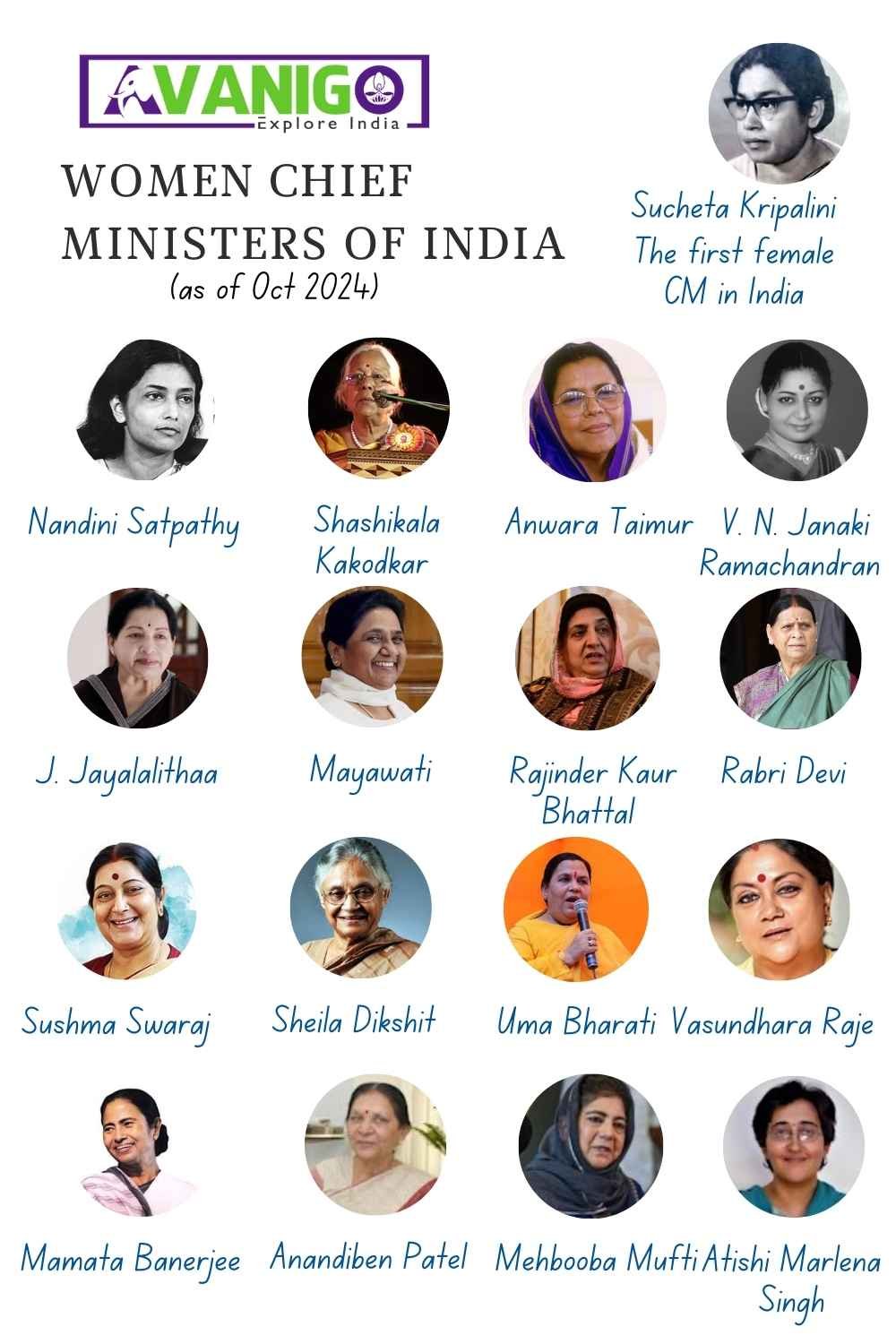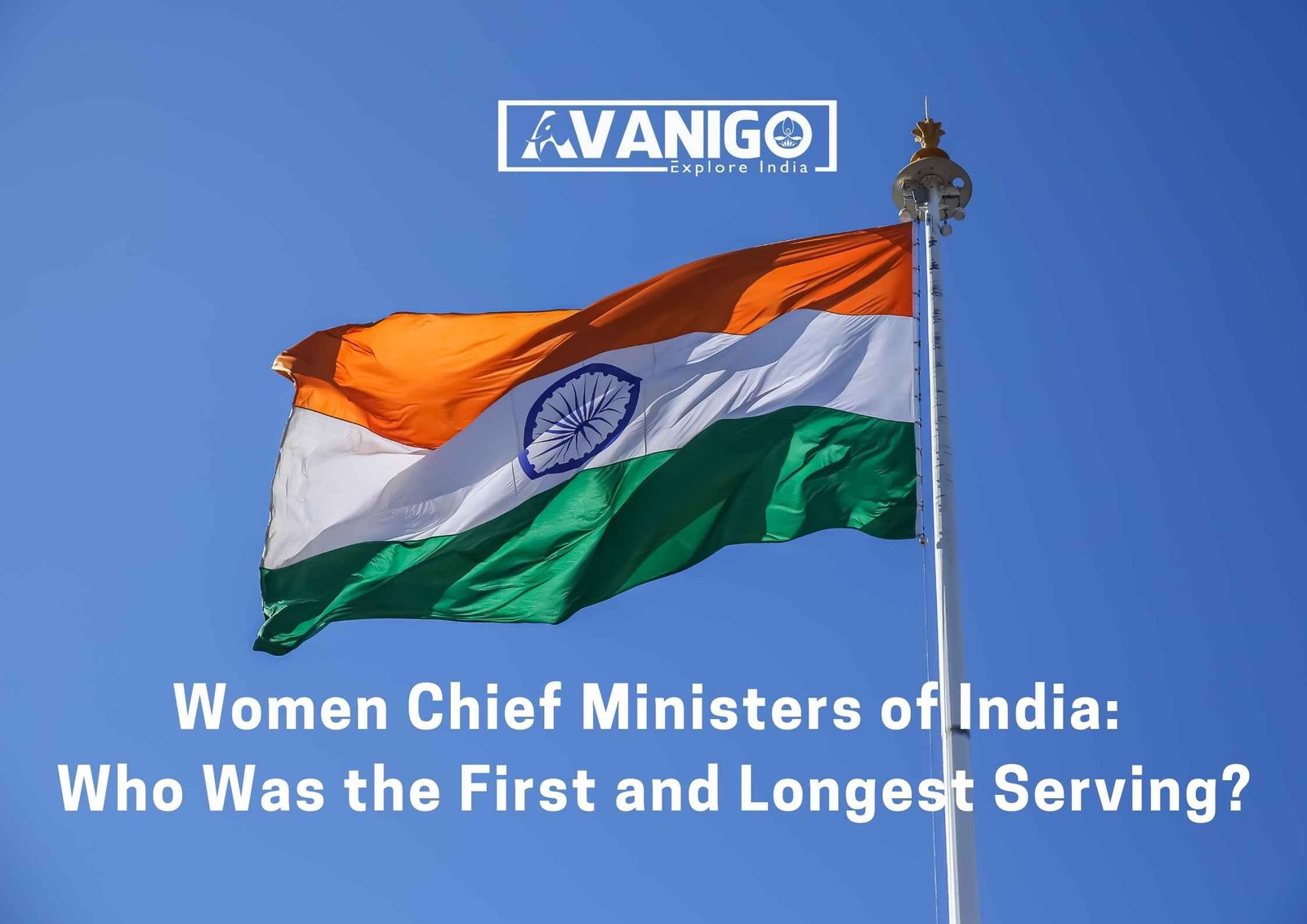India is a vast country comprising 28 states and 8 union territories, as of 2024. A Chief Minister oversees the people and the development work in each state. Although most chief ministers have been men, some remarkable women also took on this great responsibility. They strove hard to improve the quality of life of the people, leaving an indelible impression on the people. This article takes us to various women chief ministers of India who topped that position with complete dedication. We will also learn about who was first woman chief minister of India. We have also covered tenures of these women chief ministers who served her people for the longest time in office.
Quick Navigation
Sucheta Kripalani (Uttar Pradesh)
Sucheta Kripalani is the first woman chief minister of India. She served as the state’s Chief Minister of Uttar Pradesh from 1963 to 1967. She was born in the year 1908. She was a little girl when she joined the fight for freedom from British rule in India.
After Independence, she entered politics and played her part in the development of Uttar Pradesh. Fighting as Chief Minister, Sucheta Kripalani did her best to develop the education, health, and agriculture systems and fight against poverty in the state.
Sucheta helped a lot of women and formed self-help groups for them. Even though she was in power for only 3 years, Sucheta Kripalani proved to the world that women can lead and do so effectively.
Nandini Satpathy (Odisha)
Nandini Satpathy was the first woman chief minister of India state Odisha. She was born in 1931. She held the rank of CM twice, from 1972 to 1973 and then again from 1974 to 1976.
In her capacity as CM, Nandini Satpathy sought to enhance the state in priority areas like education, social order, and agriculture. She aimed to lift the needy farmers and the villagers out of poverty.
Nandini Satpathy opened colleges and schools to promote education. She showcased true grit as a woman in leadership and showed the world what, with hard work and perseverance, one can do despite being in a male-dominated society.
Shashikala Kakodkar (Goa)
Shashikala Kakodkar became the first woman chief minister of the India state of Goa in 1973. She was born in 1935. Her reign lasted for nearly 6 years till 1979.
During her term, Shashikala Kakodkar undertook developmental projects and pushed for industries in Goa. As the head of the state, she raised tourism issues and preserved Goa’s cultural identity. She commissioned new schools, roads, hospitals, and other public facilities.
Shashikala Kakodkar ensured the rights of women and children were protected through new laws. Under her leadership, Goa progressed economically as well as socially.
Anwara Taimur (Assam)
Do you know who is the first woman chief minister of India in the East? The first woman Chief Minister of Assam and the entire northeast India is none but Anwara Taimur.
Taimur was born in 1936 and became Chief Minister of Assam for about 6 months only in 1980-81. But during this period, she did her best by emphasizing development in the state’s agricultural, educational, health, and other infrastructural aspects.
Under her rule, new schools, colleges, and hospitals were opened in remote areas, too. Her vision was to develop all parts of Assam equally. Though politics became difficult later, Anwara Taimur’s contribution to the state was valued.
V. N. Janaki Ramachandran (Tamil Nadu)
In 1988, V. N. Janaki Ramachandran took place among women chief minister of India and became Chief Minister of Tamil Nadu. Born in 1923, she was in office for just 23 days due to political issues.
Nevertheless, Janaki Ramachandran used this brief period to address the rising living costs and unemployment. She ordered the concerned authorities to assist the low-income households.
Janaki Ramachandran wishes every kid to get educated and every village to be provided with basic amenities. Though her term ended suddenly, she was popular as a CM who was committed to people’s welfare.

J. Jayalalithaa (Tamil Nadu)
One of India’s most influential women chief minister was J. Jayalalithaa, who ruled Tamil Nadu for over 14 years between 1991 and 2016. Jayalalithaa was born in 1948 and is among the longest serving woman chief minister of India. She dealt with farm-related issues: loan waivers, schemes for girls/students, job quotas, low-cost housing, and power supply.
Jaya aided with laptops, mixies, cows, and goats. Tamil Nadu’s economy grew as new industries developed. Jayalalithaa was strict yet caring and was given the name “Amma,” which means mother. Due to her outstanding leadership, Tamil Nadu progressed tremendously in many areas.
Mayawati (Uttar Pradesh)
Mayawati, born in 1956, worked for the upliftment of backward classes. As Uttar Pradesh CM between 1995-2012, she focused on education, employment and self-employment. New universities and engineering/medical colleges were set up. Roads, power infrastructure, and townships were constructed.
Public transport, women’s security, and ration/pension schemes helped people experiencing poverty—a park named after Dalit icon Bhim Rao Ambedkar was erected. Under Mayawati, Uttar Pradesh saw visible development and economic boom. A lot of youth found jobs in government services, too. Her social welfare model was widely recognized as “Progressive Politics.”
Rajinder Kaur Bhattal (Punjab)
Punjab got its first chief minister of India woman in 1996 with Rajinder Kaur Bhattal. Born in 1945, she served for over three months, focusing on agriculture and rural development.
Various initiatives included the construction of schools, hospitals, roads, other economic activities, and canal irrigation systems. Under her leadership, women’s self-help groups were initiated.
Bhattal, though her term was cut short due to political reasons, left an enduring legacy of people-oriented programs. She promoted modern methods of agriculture, which increased farmers’ incomes. Rajinder Kaur Bhattal remains an inspiration for women in Punjab.
Rabri Devi (Bihar)
Bihar continuously saw Rabri Devi as the Chief Minister for seven years between 1997 and 2005. Born in 1950, she assumed office after her husband stepped down. Rabri Devi made important decisions even as a homemaker and a leader.
New schools and health centers came up in remote villages. Power connections reached more households. Buses, roads, and bridges benefited citizens. Mid-day meals in schools addressed hunger and supported education. Rabri Devi proved that with resolve, women can lead any state effectively.
Sushma Swaraj (Delhi)
Born in 1952, Sushma Swaraj became first chief minister of India woman of Delhi, for a short period in 1998. In the two months she was at the office, she directed authorities to speed up development works. Sushma Swaraj urged the upgrading of unauthorized colonies and proposed low-cost housing for the underprivileged. She reviewed measures to enhance women’s security in public places. Sushma Swaraj’s ideas helped lay a strong base. Later, as a celebrated Union Minister, she remained dedicated to public service and the nation’s progress.
Sheila Dikshit (Delhi)
The record of longest serving woman chief minister of India is held by Sheila Dikshit, the Chief Minister of Delhi, for 15 years from 1998-2013. Sheila Dikshit was born in 1938 and was the only politician who revolutionized its infrastructure. Connecting the dots were metro trains, flyovers, upgraded roads, and an improved public transport system. Power and water supply grew reliable. Pension schemes, health insurance, and world-class sports facilities came up. Green drives, like planting trees across Delhi, made it livable. Tourism projects saw immense footfalls. Public schools were developed with computers and labs. Low-cost housing also began. Under Sheila Dikshit, Delhi emerged as a bright and vibrant capital city.
Uma Bharati (Madhya Pradesh)
Uma Bharati headed Madhya Pradesh for nearly eight months in 2003-04. Born in 1959, she emphasized farmer loan waivers, irrigation projects, and rural electrification.
New schools and anganwadis opened in remote regions, too. Roads were constructed connecting far-flung villages with cities. Uma Bharati pushed for industries and micro-enterprises to generate jobs for youth and women.
Although her term was cut short, the positive changes she drove impacted many villagers in Madhya Pradesh. Her Hindutva beliefs inspired scores of patriotic women leaders nationwide, too.
Vasundhara Raje (Rajasthan)
Vasundhara Raje led Rajasthan as its Chief Minister for two consecutive terms – from 2003 to 2008 and 2013 to 2018. Born in 1953, she prioritized water conservation and management under the Jal Swavalamban and Garima schemes.
Loan melas were held to assist entrepreneurs. IT units came up through investment summits. Tourism villages program boosted rural livelihoods. Raje launched special initiatives to promote girls’ education and protection.
New medical and engineering colleges boosted the prospects of rural youth. Her good governance saw “Invest Rajasthan” globally renowned as an investor-friendly destination.
Mamata Banerjee (West Bengal)
The current longest-serving woman Chief Minister, Mamata Banerjee, has been governing West Bengal since 2011. Born in 1955, she runs several projects for women, farmers, and children’s nourishment.
The Kanyashree, Rupashree, and Swasthya Sathi schemes bear fruits. New large-scale industries are being set up under the ‘Banglar Udyan’ program, which creates employment opportunities to a large extent.
Colleges and universities have been set up that focus on promoting the study of the rich traditions and practices of the Bengal state.
Anandiben Patel (Gujarat)
Anandiben Patel served as Gujarat’s first woman Chief Minister from 2014 to 2016. Born in 1941, she concentrated on girls’ welfare schemes. New medical colleges were constructed to boost healthcare access. Employment hubs in textiles and engineering grew the economy. Farmers obtained drip irrigation sets and subsidies on inputs. ‘Swarnim Jayanti Mata-no-Madir’ focused on uplifting disadvantaged women. Anandiben introduced measures to strengthen law & order too. Though her term was cut short, she laid a strong base for Gujarat’s progress through her ability to administer.
Mehbooba Mufti (Jammu and Kashmir)
Jammu and Kashmir witnessed the first woman Chief Minister of the state, Mehbooba Mufti, in 2016 after her father’s passing. She was born in 1959, and despite the odds, she wanted to bring peace through conversation.
New industrial estates led to the creation of local jobs and self-employment training. Scholarships were given to students to help them further their education. Mehbooba was concerned with promoting art, crafts, and music in J&K as she tried to preserve its rich cultural heritage.
Her social welfare programs also alleviated poverty and malnutrition in pockets of the interior regions. Political strife, of course, truncated her term, but Mufti did a great deal in the improvement of J&K, particularly its women.
Atishi (Delhi)
Having previously held the position of Education Minister, Atishi was appointed Chief Minister of Delhi in September 2024 at 43, becoming the youngest to do so. She is still doing great things but has new initiatives, as she had served before as Education Minister.
To enhance the quality of government schools, Education Revolution 2.0 has been launched. A Happiness Curriculum has been implemented so that the children’s overall health is cared for. Non-government organization programs focusing on girl-child education aim to empower the girl child, ensuring a bright future.
Atishi has also focused on providing access to quality health care, environmental conservation, and infrastructural development in Delhi, comparable to cities worldwide.
Conclusion
Several decades after the independence of India, these pioneering women worked hard to become women chief ministers of India. Each one showed selfless devotion to the advancement of the people, be it improving their livelihoods, education, and health care or creating infrastructures or jobs. Their leadership style showed that women can lead equally well through vision, administration, and public service if given an opportunity. These 17 female chief ministers (as of October 2024) and their life stories will inspire many more girls to take up positions of power and serve in building the nation proactively. Their impact will be forever engraved in the annals of the history of Indian politics, which has been dynamic and progressive.
Swetha is a Content Specialist, LinkedIn Branding and B2B Marketing Consultant. When she is not in the world of B2B, she researches the roots and beauty of Indian Culture and Traditions. She is the author of the book: 365 Days 365 Posts – The Guide to LinkedIn Personal Branding, available exclusively on Amazon. Connect with her on LinkedIn.

